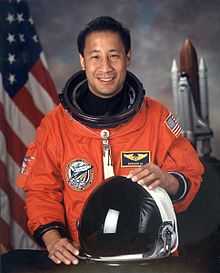Ed Lu
| Edward T. Lu 盧傑 | |
|---|---|
 | |
| NASA Astronaut | |
| Nationality | American |
| Status | Retired |
| Born |
July 1, 1963 Springfield, Massachusetts |
| Other occupation | Physicist |
| Time in space | 205d 23h 18m |
| Selection | 1994 NASA Group |
| Missions | STS-84, STS-106, Soyuz TMA-2, Expedition 7 |
| Mission insignia |
|
Edward Tsang "Ed" Lu (Chinese: 盧傑; pinyin: Lú Jié; born July 1, 1963) is an American physicist and a former NASA astronaut. He is a veteran of two Space Shuttle missions and an extended stay aboard the International Space Station.[1]
Education
Raised in Webster, New York, to a Chinese family. Lu attended R. L. Thomas High School, where he was a member of the wrestling team and graduated in 1980. Later, Lu earned a degree in electrical engineering from Cornell University where he lettered in wrestling. He then received a doctoral degree in applied physics from Stanford University in 1989.[1] Lu is a member of the Psi chapter of Pi Kappa Phi fraternity at Cornell.
Lu is a specialist in solar physics and did postdoctoral work at the Institute for Astronomy in Honolulu, Hawaii before being selected for the NASA Astronaut Corps in 1994.[1]
NASA career
Lu flew on space shuttle missions STS-84 in 1997 and STS-106 in 2000, in which he carried out a six-hour spacewalk to perform construction work on the International Space Station. Having been flight engineer on Soyuz TMA-2, Lu spent six months in space in 2003 as part of ISS Expedition 7, with cosmonaut Yuri Malenchenko.[1] In July 2003, Lu and Malenchenko answered questions from students participating in Japan's NASDA special educational event, where Ed Lu performed Happy Birthday on an electronic piano for a student's birthday in the live broadcast from space.[2][3] He had demonstrated the difficulty of playing the piano instrument in space during a live in-orbit interview with CBS News and NASA TV video feed.[4] Also on this ISS mission on 15 October 2003, Lu communicated with the crewman of China's first manned mission into space, Yang Liwei, flying aboard Shenzhou 5. Lu congratulated the Chinese for the achievement and said in Putonghua: "Welcome to space. Have a safe journey". Malenchenko added: "I love to have somebody else in space instead of (just) me and Ed".[5]
In his spare time while at NASA, Lu founded the B612 Foundation whose goal is to be able to significantly alter the orbit of an asteroid, in a controlled manner, by 2015.[1]
Magic trick in space
While on the ISS, Lu teamed up with magician James Randi (founder of JREF) to perform a card trick in outer space. Randi asked Lu to (without looking) select a card from the middle of a brand new freshly shuffled deck of cards, turn it around and reinsert the card into the deck the opposite direction. Then place the deck of cards back into its box then take them out again and fan the cards to the camera. This same procedure was being done by Randi back on Earth at the JREF headquarters in front of witnesses from the Miami Herald. Both Randi and Lu successfully selected the same card, the seven of diamonds. The remaining cards were jettisoned for weight reasons before returning to Earth, but Lu smuggled the card home. The two cards complete with autographs are framed for public view at the JREF offices in Fort Lauderdale, FL. Randi asks Lu "What are the odds that we would both choose the same card?" Lu answers "Knowing you and your tricky ways, the odds were one in one, because it's a trick!"[6]
After NASA
On August 10, 2007, Lu announced he was retiring from NASA to work at Google.[1][7]
In June 2010, Lu left Google and worked out of the Sunfire Offices.[8]
Starting in September 2011, Lu joined Liquid Robotics as Chief of Innovative Applications, where his work includes outreach to promote new applications for ocean science.[citation needed]
As of February 2012, Lu joined Hover Inc. as the Chief Technology Officer.[9]
On June 28, 2012, Lu, with Apollo 9 Astronaut Rusty Schweickart and G. Scott Hubbard, Astronautics professor and Author from Stanford University launched the B612 Foundation to build and operate the first privately-funded deep space mission called Sentinel. The non-profit foundation will launch an infrared space telescope in orbit around the Sun, about 170 million miles from Earth, where it will detect and track all moving objects, including asteroids posing threats to life on Earth.
See also
References
![]() This article incorporates public domain material from websites or documents of the National Aeronautics and Space Administration.
This article incorporates public domain material from websites or documents of the National Aeronautics and Space Administration.
- ↑ 1.0 1.1 1.2 1.3 1.4 1.5 NASA (2000). "Ed Lu Biography". NASA. Retrieved October 6, 2008.
- ↑ Expedition 7 Video Index
- ↑ http://spaceflight1.nasa.gov/gallery/video/station/expedition7/net56/nasda2_56.asf
- ↑ Piano in space - YouTube
- ↑ NASA - Expedition 7 Crew Members Welcome China to Space
- ↑ Card Trick in Space ~ Ed Lu & Randi - YouTube
- ↑ Beutel, Allard (2007-08-10). "Astronaut Ed Lu Leaves NASA". NASA. Retrieved 2007-08-12.
- ↑ Sunfire Offices
- ↑ "Google Unveils New Maps Features Amid Apple Fight". Silicon Valley News. June 6, 2012. Retrieved July 1, 2012.
External links
- NASA biography
- Dr. Lu's Space Blog written from during Expedition 7
- Spacefacts biography of Ed Lu
- Asteroid Apocalypse: The Tech Exists to Deflect Asteroids, So Why Aren't We Using It?, PJTV, 4 April 2013, interview with Ed Lu about the B612 Foundation and asteroid detection.
| |||||||||||||||||||